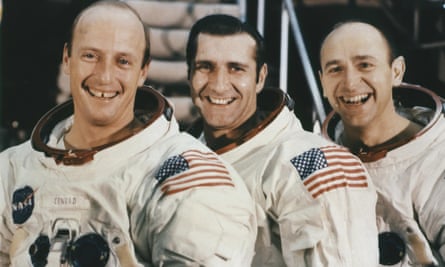The astronaut Alan Bean, a member of Nasa’s Apollo 12 mission, who has died aged 86, was the fourth person to step on to the surface of the moon, and the only one to go on to depict the view from outer space in paintings. His fellow astronaut John Glenn described Bean’s work as seeing “the same monochromatic world as [we did] ... yet with an artist’s eye he also saw intrinsic beauty”.
Apollo 12, commanded by Pete Conrad, was launched in November 1969, only four months after Neil Armstrong and Buzz Aldrin had first stepped on to the moon’s surface from the Apollo 11 lunar module. The Apollo 12 astronauts set up a nuclear generator in the Ocean of Storms to provide a power source; Bean, of Scottish descent on his father’s side, carried a piece of MacBean tartan with him. He gathered many samples of rocks and lunar soil, including a green stone he described as “ginger ale bottle glass” – geologists later identified it as the mineral olivine.
The Apollo 17 astronaut Harrison Schmitt, the only geologist to have walked on the moon, described those samples as “the gift that keeps on giving”. Schmitt later served as a source for Bean about details of the lunar landscapes he painted. “If I were a scientist I would paint it grey,” Bean explained. “I’m an artist, so I can add colour to the moon.”

Bean was born in Wheeler, in the Texas Panhandle. His father, Arnold, was a soil scientist with the US Department of Agriculture; his mother, Frances, provided the anchor as they moved frequently, before finally settling in Fort Worth. Alan went to the University of Texas on a naval officer training programme, receiving his degree in aeronautical engineering in 1955. He also wrestled on the university’s team, though he later said he really wanted to be a gymnast or diver.
He was commissioned as an ensign in the US Navy and served his four-year commitment flying fighters at the Jacksonville Naval air station, Florida, after which he decided to remain in the service and was assigned to test pilot school, where one of his instructors was Conrad, who would command Apollo 12.
He was accepted, on his second try, into the astronaut programme with the third intake in 1963, alongside Conrad and the third Apollo 12 crew member, Dick Gordon. When Clifton Williams, originally the third member of Conrad’s team, died in an air crash, Conrad requested Bean as his replacement, and they served as the backup crew for Apollo 9 before being assigned the Apollo 12 mission.
In 1973 Bean commanded Skylab 3, the second manned Skylab mission; Conrad had commanded the first. He made a spacewalk from Skylab, spending 59 days in orbit and travelling 24.4m miles. In all, Bean logged 69 days 15 hours and 45 minutes in space.

He retired from the navy in 1975, and spent the next six years training astronauts before leaving Nasa in 1981 to become a painter. He later said many of his fellow astronauts thought he was going through a mid-life crisis. His paintings are notable for their attention to detail, and by tiny pieces of the patches from his space suit, imbued with moon dust, that he used on their surface. They are marked also by a good deal of emotion, and sometimes by drama.
Gordon, who remained in orbit around the moon while Conrad and Bean took the lunar module down, was scheduled to command Apollo 18. That mission would be cancelled, and Apollo 17 remains the last flight to the moon; so Gordon lost his chance to walk on the moon’s surface. In 1993 Bean painted The Fantasy, which showed all three men standing together on the moon.
Bean published a memoir My Life As an Astronaut, in 1988. He wrote Apollo: An Eyewitness Account (1998) and Mission Control, This Is Apollo (2009) with Andrew Chaikin, as well as contributing to a book about the aviation artist William S Phillips. On the 40th anniversary of Apollo 11 in 2009 the Smithsonian Institution’s Air and Space Museum in Washington staged an exhibition of Bean’s work, titled Painting Apollo: First Artist on Another World. He worked intensely, saying: “I feel like there’s too many paintings left unpainted that I just don’t want to take time away.”
Bean’s paintings sold, often via his own website, for as much as $175,000. He also achieved an unexpected place in popular music, being the subject of the Swedish singer Stina Nordenstam’s 1991 song The Return of Alan Bean and the British indie band Hefner’s 2001 song Alan Bean.
He is survived by his second wife, Leslie (nee Clem), whom he married in 1978, and by a son, Clay, and daughter, Amy Sue, from his first marriage, to Sue Ragsdale, which ended in divorce.

Comments (…)
Sign in or create your Guardian account to join the discussion